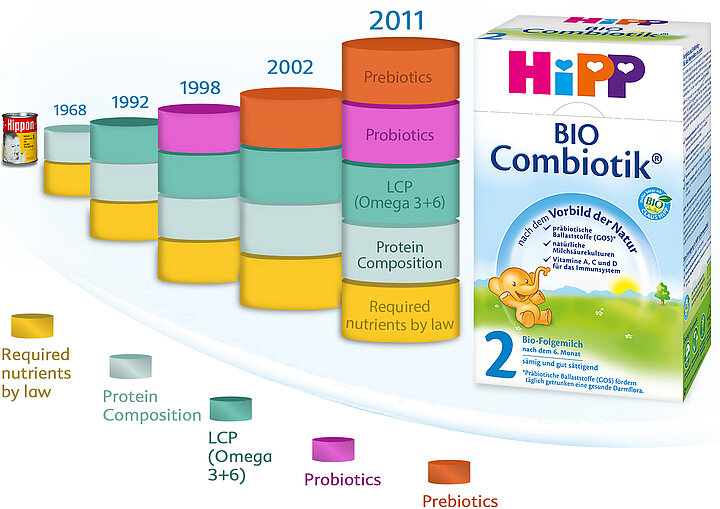1968: Adapted milk formula
Protein composition similar to breast milk.
Breast milk protein differs in composition from cow's milk. While cow's milk contains 80% casein and 20% whey protein, in breast milk the proportion is almost the opposite. Breast milk contains only 40% casein and 60% whey protein.
Adapting the protein composition of infant formulas by adding whey protein was the first important step in making milk formulas similar to breast milk, which is ideal, and therefore more easily tolerated by babies.
1992: LCP Fatty acids
Breast milk contains fatty acids specifically designed for the baby's body, which are important for the development of the brain, nerve cells, and vision. These omega-3 and omega-6 fatty acids are called "long chain polyunsaturated fatty acids" or "LCP", or "LCPUFA". The first imitation of these LCPs consisted of eggs and fish oils. Today, special vegetable oils are also used, which have a more pleasant taste.
LCPs are important for a baby's development, especially in the first months of life, because at this age the body cannot yet produce them on its own. So, when choosing a baby formula, check that it contains LCPs.
1998: Probiotics
Probiotics: Special cultures for the baby's intestines.
Breast milk contains a variety of probiotic cultures that may differ individually. The probiotics in breast milk are passed on to the baby during breastfeeding and attach to the wall of the intestine where they expel unwanted germs. Therefore, they ensure a healthy intestinal flora and a strong immune defense in infants. That is why breastfed babies are particularly well protected.
Since 1998, infant formulas have been on the market that imitate this protective principle of breast milk by also containing probiotics. In 2002, HiPP was the first brand to use natural lactic acid bacteria cultures isolated from breast milk, which belong to the natural colonizers of the human intestine.
2002: Prebiotics
Prebiotics: fibre that serves as food for probiotics.
Breast milk contains large amounts of prebiotic oligosaccharides. These promote the growth of positive probiotics so that they can multiply better and form a protective coating in the baby's intestines.
Since 2002, some infant formulas have used prebiotic dietary fibres, which ensure a healthy intestinal flora similar to that of breastfed infants. These include galacto-oligosaccharides (GOS) obtained from natural lactose which are similar to those in breast milk. Some brands also use isolated fructo-oligosaccharides (FOS) from the plant cichorium.
2011: Probiotics and Prebiotics
Breast milk contains the combination of probiotics and prebiotics that support each other to protect the immune system of breastfed children. Therefore, breast milk not only provides babies with protective probiotic cultures or prebiotic dietary fibres, but with a combination that contributes to the particular "nest protection" of breastfed babies.
After years of research, in 2010 HiPP was the first brand to launch a new generation of growth formulas containing a combination of probiotics which are natural lactic acid producing microorganisms (Lactobacillus fermentum) and prebiotic dietary fibres (GOS). Prebiotic dietary fibres develop a healthy gut, modelled on breastfed babies.
As of March 2011, this combination is now also available in all HiPP COMBIOTIC® organic infant formulas.
Through the COMBIOTIC formulas, HiPP offers the public a wide range of infant formulas and follow-on formulas with natural lactic acid cultures and prebiotic dietary fibres for children who are not breastfed.
This way, HiPP offers a full range of infant formula and follow-on formula with natural lactic acid cultures and prebiotic dietary fibers for non-breastfed children.

